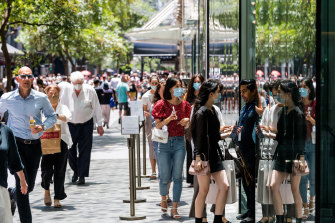‘We still love to browse’: Bricks and mortar stores make post-lockdown comeback
Traditional bricks and mortar retailers in Sydney and Melbourne have bounced back after COVID-19 lockdowns as consumers return to old shopping habits in the pre-Christmas rush.
But a real-time spending tracker shows purchasing at major online retailers remains well above pre-COVID levels. This suggests online shopping has become more entrenched following the pandemic.
Shoppers at Sydney’s Pitt Street Mall. Spending in stores has recovered strongly since lockdowns.Credit:James Brickwood
The tracker, developed by consultancy Accenture and credit bureau illion, shows in-store spending recovered rapidly once restrictions on mobility were lifted, especially at clothing outlets where purchases are 12 per cent above the pre-COVID norm. Department stores and general merchandise retailers are back to pre-COVID trading.
Spending at big online retailers such as Amazon, eBay and Kogan was 259 per cent higher than the pre-COVID-19 norm during the lockdowns. Purchases at those outlets has remained 106 per cent higher than the pre-pandemic levels despite the easing of restrictions.
Accenture managing director, Andrew Charlton, said those “pure” online retailers “basked in glory during lockdown” and were still faring well.
“But we can definitely see people still love going to shops to browse and buy,” he said.
Economists have predicted bumper spending this Christmas season fuelled by a build-up in household savings, government stimulus and record low interest rates.
ANZ senior economist Adelaide Timbrell said the bank’s card data shows spending in the week to December 18 was comparable to robust pre-Christmas trading conditions last year.
“We are most likely in for another really strong end of year spending rush,” she said.
Nicholas Robinson, director of data, analytics and insights at illion, said high vaccination rates may have encouraged more in-store retail shopping in the lead up to the holidays.
“While the data suggests that online shopping is here to stay, there is clearly still a place for bricks and mortar stores which often provides a more satisfying and interactive retail experience,” he said.
The tracker draws on anonymised weekly bank transaction data of hundreds of thousands of consumers. It was used to compare spending at traditional and online retailers in Sydney and Melbourne during the lockdowns (July 19 to October 10) and after the reopening period (October 11 to December 5). Spending was also compared to the pre-COVID norm.
Fashion stores were hit especially hard by the lockdowns but have made a strong comeback.
“Out of all the retailers we have been analysing, clothing stores are the clear winners in terms of spending surges out of lockdown,” Dr Charlton said.
The analysis showed Myer fared better than David Jones and Kmart during lockdowns although spending at department stores overall has now bounced back by roughly equal magnitudes since restrictions were eased.
Among the pure online retailers evaluated by Accenture and illion, eBay saw the biggest sales jump during lockdowns (430 per cent up on the pre-COVID norm) followed by Kogan (up 304 per cent), Alibaba and AliExpress (up 200 per cent) and Amazon (up 190 per cent). Spending at all those online retailers has declined since lockdowns ended but remains well above pre-COVID levels.
Ms Timbrell said it was “very unlikely” the share of online spending would fall back to pre-pandemic levels.
“We have seen huge increases in the amount of shopping that has happened online through lockdowns, but then it doesn’t come all the way back to pre-lockdown levels. It has pushed more and more people into that [online shopping] experience and that will stick.”
The Morning Edition newsletter is our guide to the day’s most important and interesting stories, analysis and insights. Sign up here.
Most Viewed in Business
From our partners
Source: Read Full Article



